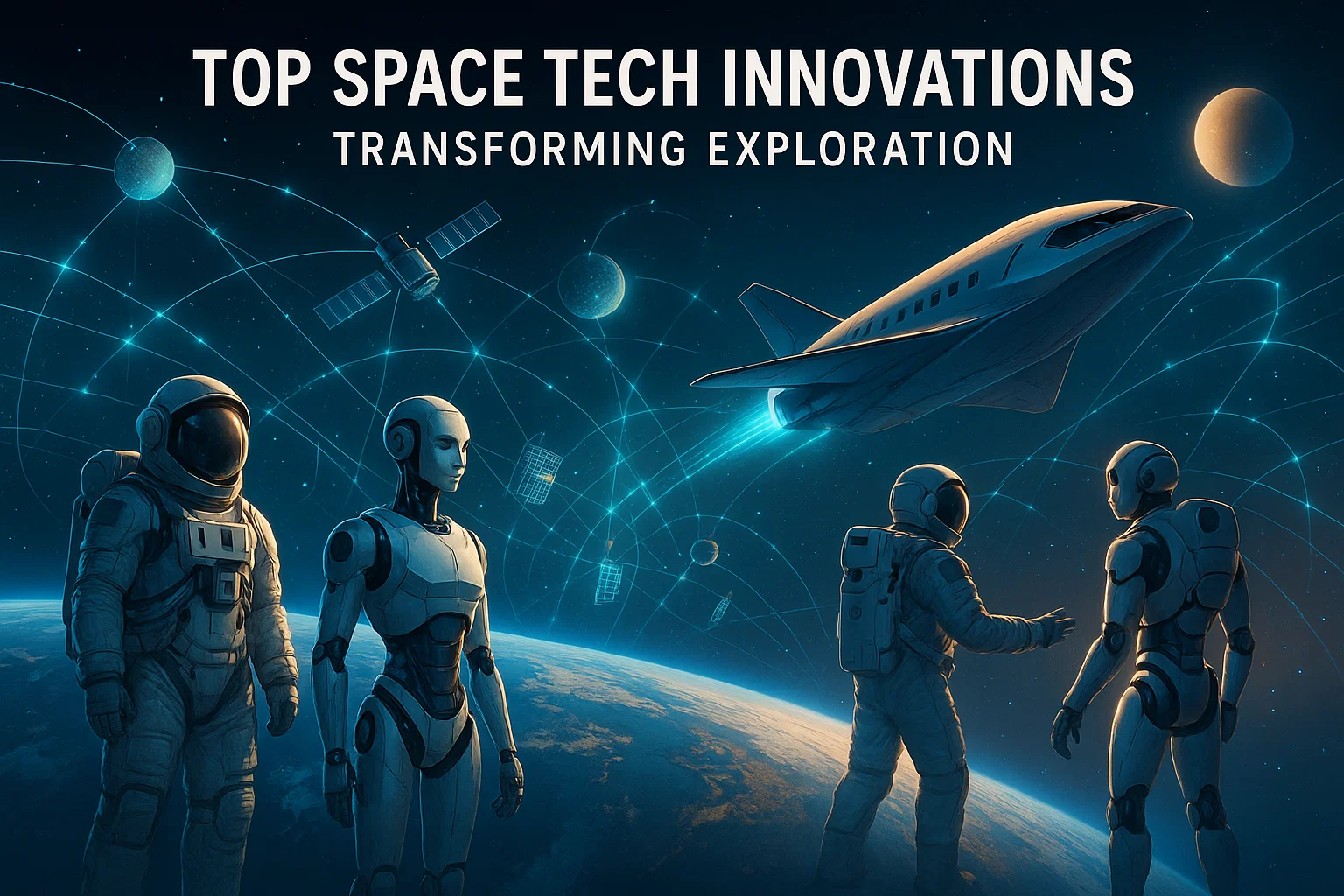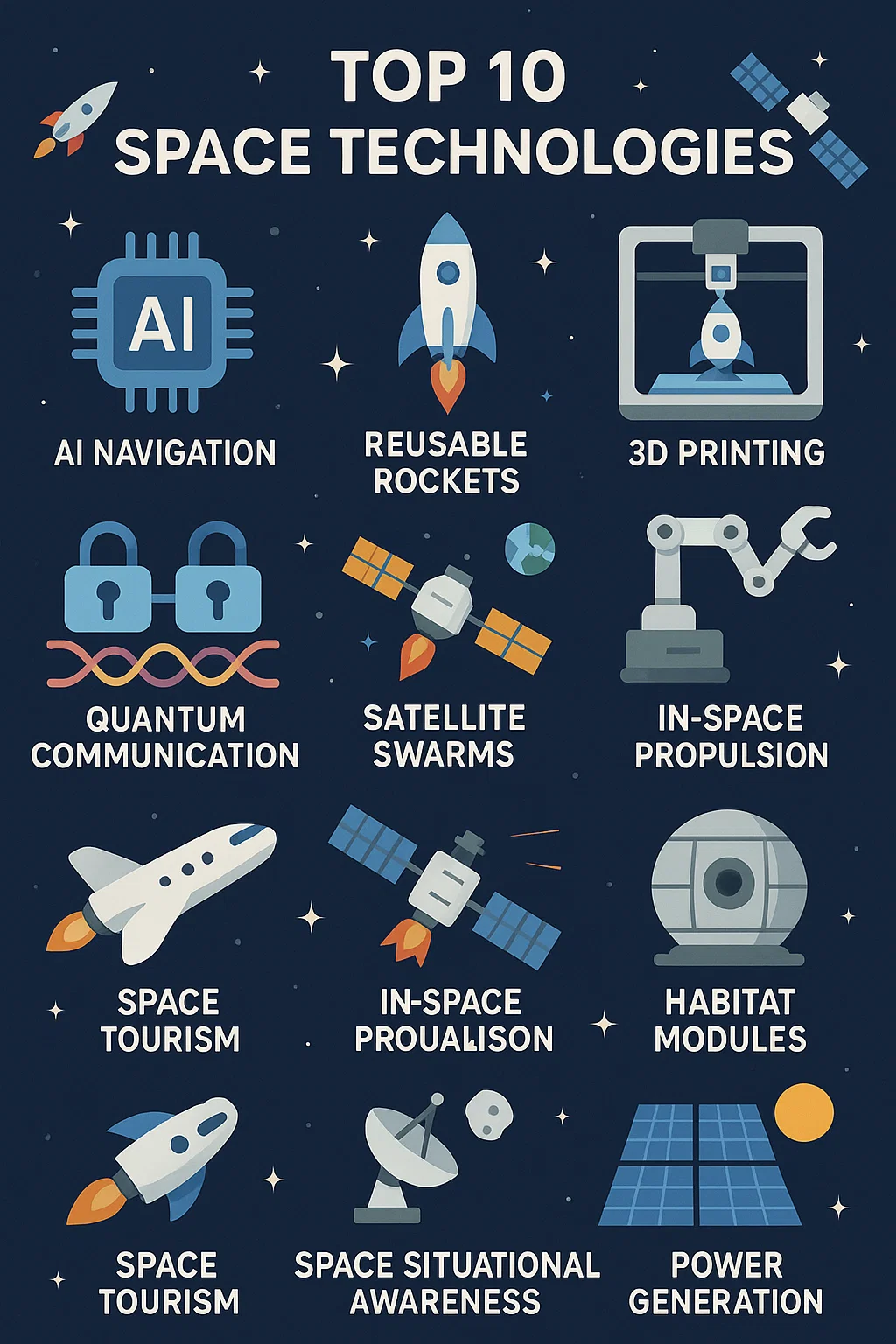 When you look up at the night sky in 2025, you’re not just seeing stars you’re looking at the next frontier of human technology. From artificial intelligence guiding rovers across Mars to reusable rockets slashing launch costs, space tech has evolved faster in the past decade than in the previous half-century.
When you look up at the night sky in 2025, you’re not just seeing stars you’re looking at the next frontier of human technology. From artificial intelligence guiding rovers across Mars to reusable rockets slashing launch costs, space tech has evolved faster in the past decade than in the previous half-century.
Today, space technology isn’t just about exploring distant planets. It’s shaping communications, weather prediction, and even sustainability on Earth. Behind every launch or satellite lies a fusion of AI, robotics, materials science, and data engineering that’s transforming how humanity interacts with the cosmos.
Let’s explore the most groundbreaking innovations driving this new space era and why they matter for life here on Earth.
Why Space Technology Matters in 2025 and Beyond
In 2024, the global space economy surpassed $560 billion, according to the Space Foundation. What’s driving this growth? A mix of private investment, public research, and the technological revolution that makes space more accessible than ever before.
Governments once dominated the skies, but now private firms SpaceX, Blue Origin, Rocket Lab, and Relativity Space are rewriting the playbook. The cost of getting to orbit has fallen by over 90% since the early 2000s, turning space exploration into an open arena for startups, universities, and nations.
Why does this matter? Because space technology doesn’t stay in space.
It improves life on Earth. GPS, satellite internet, solar panels, and even the camera in your smartphone all began as space-driven innovations.
In short:
Space tech fuels progress. It’s the testing ground for the world’s toughest problems from sustainable energy to AI autonomy.
The Core Technologies Powering Space Exploration
| Technology | Purpose | Real-World Example | Impact |
|---|---|---|---|
| AI & Machine Learning | Autonomy, navigation, data analysis | NASA Perseverance rover | Enables self-guided exploration |
| Reusable Rockets | Reduce launch cost and waste | SpaceX Falcon 9 | Cuts launch cost from $100M to $10M |
| 3D Printing | On-site part production | Made In Space ISS printer | Lowers payload weight, enables repairs |
| Smart Robotics | Exploration in harsh environments | JAXA Hayabusa2, NASA InSight arm | Extends human reach safely |
| Quantum Communication | Secure data transmission | China’s Micius satellite | Unhackable space communication |
These five pillars represent the backbone of modern space innovation. Let’s break them down one by one.

AI and Machine Learning in Deep Space Missions
Artificial Intelligence is the brain of today’s space exploration.
In 2021, NASA’s Perseverance rover landed on Mars with a new companion an AI-driven system called Terrain Relative Navigation (TRN). This onboard AI scans the Martian surface during descent, identifies safe landing zones, and steers the craft in real time. No human pilot could react that fast.
AI also helps analyze the terabytes of data gathered from telescopes and satellites. For instance, machine learning algorithms process images from the James Webb Space Telescope to identify distant galaxies and exoplanets automatically.
According to IEEE Spectrum, “AI now acts as both a navigator and a scientist in space missions.” This shift frees human engineers from manual data sifting, enabling faster discoveries.
Real-world example:
ESA’s Gaia mission uses AI to map 1.8 billion stars, building the most detailed 3D map of our galaxy to date.
Diagram idea:
“AI Decision Flow in Mars Rover Operations” – showing sensors → machine learning module → terrain prediction → navigation command.
Reusable Rockets: The Game-Changer
If one innovation defines the new space age, it’s reusability.
Before 2015, every rocket launched into space was essentially a one-way ticket used once and discarded. That changed when SpaceX landed its first Falcon 9 booster, proving rockets could be reused safely.
Reusable systems have cut launch costs dramatically:
- Traditional launch: around $100–200 million per flight
- Reusable launch: as low as $10–15 million
This cost revolution has unlocked frequent launches, enabling satellite constellations like Starlink and planetary missions that once seemed financially impossible.
Other players followed suit:
- Blue Origin’s New Shepard for suborbital flights
- Rocket Lab’s Neutron reusable small launcher
- ArianeGroup’s Prometheus engine reusable methane-fueled design from Europe
Reusable vs. Traditional Rockets
| Feature | Traditional Rocket | Reusable Rocket |
|---|---|---|
| Cost per Launch | $100–200M | $10–15M |
| Turnaround Time | 6–12 months | 1–4 weeks |
| Environmental Impact | High fuel waste | Lower CO₂ and debris |
| Reliability (Post-Testing) | Moderate | Increasing each launch |
Reusable rockets are to space what electric vehicles are to roads: a clean, cost-effective shift in engineering mindset.
3D Printing and On-Site Manufacturing
Imagine printing tools and spacecraft parts in orbit instead of sending them from Earth. That’s the promise of additive manufacturing better known as 3D printing.
In 2014, a startup called Made In Space (now Redwire Space) made history by printing the first wrench on the International Space Station. This wasn’t just a test it was proof that astronauts could fabricate what they need in real time, without waiting for supply missions.
Benefits include:
- Reduced launch mass: Only raw materials are sent up.
- Faster repairs: Damaged parts can be replaced immediately.
- Sustainability: Recycled plastics from old equipment can be reused.
Future missions plan to print entire habitats using Martian or lunar soil (a process called in-situ resource utilization). NASA’s 3D Printed Habitat Challenge showcased designs that could be built layer-by-layer using local materials.
“Additive manufacturing will redefine how we build in space,” says Dr. Jennifer Edmunson from NASA’s Marshall Space Flight Center.
With 3D printing, the line between Earth and space manufacturing begins to blur.
Smart Robotics and Autonomous Exploration
Before humans return to the Moon or step foot on Mars robots are leading the way.
From Japan’s Hayabusa2 mission collecting asteroid samples to NASA’s InSight probe drilling into Martian crust, robotic explorers handle what’s too dangerous or distant for humans.
Key robotic advancements include:
- Swarm robotics: Multiple small bots working cooperatively (tested in ESA’s PRO-ACT project).
- Telepresence control: Delayed but precise commands from Earth-based operators.
- Self-repairing systems: Robots that identify and fix minor mechanical faults autonomously.
Robotics also helps on the ISS, where the Astrobee free-flying robots assist astronauts with inventory and monitoring.
Visual prompt:
“Robotic exploration on the lunar surface with swarm drones scanning terrain and relaying data.”
These robotic systems act as precursors testing terrain, collecting data, and preparing the environment for future human arrival.
Quantum Communication and Space Data Security
As the number of satellites increases, space cybersecurity becomes a top concern. In 2025, we’re entering the age of quantum-secured communication.

China’s Micius satellite proved the concept first, transmitting entangled photons between Earth and orbit to create unhackable encryption keys. Europe’s EuroQCI project and the U.S. Quantum Internet initiative are building on this to secure data between space and ground systems.
Why it matters:
- Quantum encryption ensures data cannot be intercepted without detection.
- Protects government and commercial satellites from hacking or spoofing.
- Enables safe interplanetary communication networks.
“Quantum key distribution could become the backbone of future space defense systems,” reports Gartner’s 2025 Emerging Tech Report.
This is cybersecurity on a cosmic scale protecting not just your phone data, but the planet’s entire communication infrastructure.
The Role of Private Companies and Global Collaboration
Space exploration is no longer a Cold War competition; it’s a global collaboration.
Private firms now outnumber national agencies in active missions. SpaceX, Blue Origin, Rocket Lab, and Relativity Space dominate launch infrastructure, while Planet Labs and OneWeb provide real-time Earth observation and internet coverage.
Meanwhile, national agencies NASA, ESA, ISRO, JAXA, and Roscosmos focus on long-term science, planetary defense, and collaboration frameworks.
| Sector | Notable Organizations | Focus Area |
|---|---|---|
| Government | NASA, ESA, ISRO | Science, deep space, defense |
| Private | SpaceX, Rocket Lab, Blue Origin | Launch, satellites, transport |
| Hybrid | Axiom Space, Sierra Space | Space stations, commercial logistics |
This partnership model is creating the “space economy” a network of industries spanning research, energy, communication, and tourism. Morgan Stanley projects the space sector could hit $1 trillion by 2040.
Challenges Ahead Sustainability and Space Debris
For every satellite launched, there’s another piece of debris floating around Earth. According to ESA’s Space Debris Office, there are over 36,000 tracked objects larger than 10 cm and millions of smaller fragments.
| Problem | Cause | Impact |
|---|---|---|
| Space Debris | Collisions, old satellites, rocket parts | Risk to active spacecraft and ISS |
| Fuel Emissions | Rocket propellants, frequent launches | Upper-atmosphere pollution |
| Orbital Congestion | Satellite megaconstellations | Radio interference and traffic control issues |
Solutions emerging today:
- De-orbiting technologies (drag sails, controlled reentry systems).
- Biodegradable satellite materials.
- Cleaner propellants such as methane and green hydrogen.
- International debris-removal missions like ESA’s ClearSpace-1.
The future of space exploration depends not only on innovation but on responsibility. Sustainable design will determine how long we can safely operate beyond Earth.
What’s Next: The Future of Space Technology
If the 2010s were about getting back to orbit, the 2020s and 2030s will be about living and working beyond it.
Here’s what experts see coming:
- AI-powered space habitats: Self-regulating life-support systems using predictive maintenance.
- Interplanetary Internet: A network connecting Mars, Moon, and Earth via relay satellites.
- Asteroid mining: Extracting metals like nickel and platinum from near-Earth objects.
- Fusion propulsion: Faster travel using plasma engines.
- Terraforming research: Early-stage studies of ecosystem simulation in closed habitats.
“We’re witnessing a convergence of biology, robotics, and AI in space innovation,” says Dr. Klaus Müller of the European Space Agency (ESA). “The next leap isn’t just technological it’s human.”
By 2040, space may no longer be a frontier it could be a new economy, a new workplace, and perhaps even a new home.
Practical Checklist Understanding Space Tech Today
Before we dream too far ahead, here’s how you can stay connected with the real innovation happening now:
- ✅ Follow mission updates from NASA, ESA, and ISRO.
- ✅ Watch private company launch streams (SpaceX, Rocket Lab).
- ✅ Learn the basics of AI and robotics in space systems.
- ✅ Explore open-source satellite data on NASA EarthData or Copernicus Hub.
- ✅ Take free online courses on space systems engineering and astrophysics (Coursera, edX).
- ✅ Keep up with global collaborations on sustainable space policy.
These small steps can help students, engineers, and enthusiasts understand not just where we’re going but why it matters.
Final Thoughts Before You Look Up
The story of space exploration is no longer written by a handful of astronauts. It’s written by thousands of engineers, scientists, and dreamers working behind the scenes on Earth.
Every line of code in an AI navigation system, every robotic arm on a spacecraft, every test of reusable hardware brings humanity closer to a new reality: one where the stars are not out of reach but part of our connected world.
As we stand at the edge of this new frontier, one thing is clear
space technology isn’t just about reaching the stars; it’s about understanding our place among them.